Happy Camper School
October 17, 2008
MCMURDO STATION, ANTARCTICA– As the Delta drove away after dropping off our group for Happy Camper School, also known as “Snowcraft 1” and survival training, I had a distinct mix of adrenaline excitement and nervousness.
The day was cloudy and gray. The wind was up. And it was cold. But this was my first real Antarctic experience, the first time away from McMurdo Station. I was energized to learn survival skills to endure the frigid Antarctic night and help my group set up a camp on the Ross Ice Shelf.
We walked quite a long way to where we would start our training, each of us alone to our thoughts bundled against the wind. I was actually happy to leave the relative comfort of McMurdo Station. This was one of the things I was looking forward to most when I came down here, the opportunity to experience Antarctica.
Castle Rock came into view, and again I was reminded of those who came before me. The early explorers didn’t have training on how to live in this harsh environment. They were the ones who, by trial and error, passed down the knowledge that we have benefited from today. They went out seeking to comprehend the world around them as we do now, but they wrote the lessons of survival that we now follow.
I turned and looked behind me toward what was familiar and saw Mt. Discovery shrouded in clouds behind Scott Base, the New Zealand scientific research facility. I made the decision to actively be engaged in my training to absorb everything I could. There is a deep respect I have for the extreme weather which can and does occur in the Antarctic. In order to feel confident about my own ability to withstand the potential difficult moments, times that would require a clear mind and deliberate action if they teetered on the edge of life and death, I had to fully learn how to cope with my surroundings.
One of the first lessons our instructors taught us was how to use and fix a WhisperLite stove. We would later use them to make water from melted snow and to heat the water for meals, hot drinks, and to fill a bottle to keep in our sleeping bags as we slept to keep warm throughout the night. These stoves are very well suited to be used in such a cold environment because they can be lit with almost any type of fuel.
A snow shelter we were taught to make was called a Quinzee. It’s different than an igloo because an igloo uses carefully placed blocks of snow in its construction. A quinzee is made by hollowing out compacted snow. We piled up all of our duffle bags that contained our sleep kits (sleeping bags, fleece liners, and ground mats) and shoveled about 1 foot of snow on top of it. This was packed down by smacking the backside of our shovels against it. We then let it sit for about an hour so the snow crystals would lock together to form a solid structure. A hole was dug into the side of it, and the bags were removed. And what was left was a hollow mound of snow that protected against the wind and elements. The inside was excavated to make a flat sleeping surface, and it was ready to use. I chose to sleep inside of this later in the night.
Our sleep shelters were finally constructed and laid out. We had 2 orange Scott Tents, the Quinzee, and several blue and yellow Mountain tents. It’s very important how a camp be set up, and one of the most significant things is to determine where the dominant wind is coming from. This will likely be the direction from where the most severe weather would come. All of the entrances to the shelters were placed away from the wind.
The next thing our instructors taught us after our sleep structures were set up was how to excavate snow blocks. We would use these to construct walls around our camp to prevent the full force of the wind from getting to us. We put them around the Mountain tents and the area where we would be setting up the stoves to melt snow for drinking water.
After all of our hard work, the clouds mostly cleared out and it became a beautiful evening. Our camp was set up. Everything was secure. We ate dinner and warmed up with hot drinks.
I was really tired after being outside the whole day in the cold. I set up my sleeping bag in the Quinzee and got ready to spend my first night out on the Ice in Antarctica.
With a full belly and a warm water bottle to help heat my sleeping bag, I turned and looked toward one of the last sunsets on the continent for the season. I was amazed. I had made it. I was now in Antarctica!


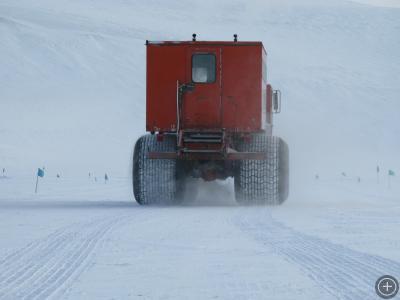
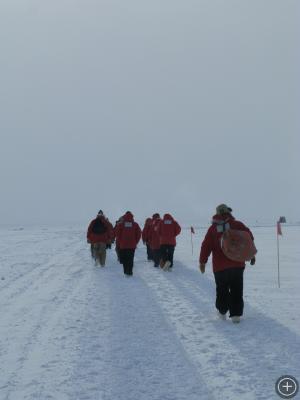
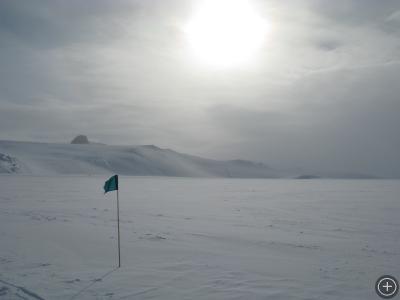
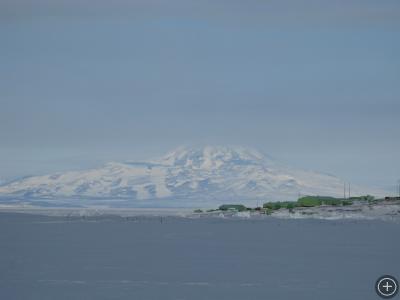
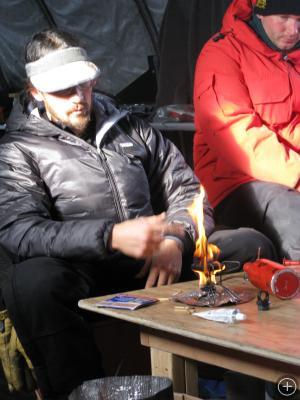
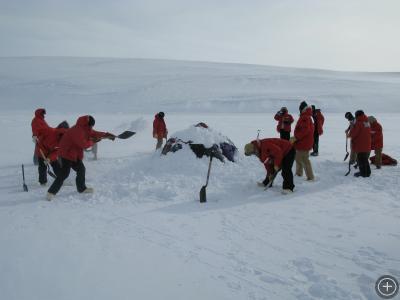
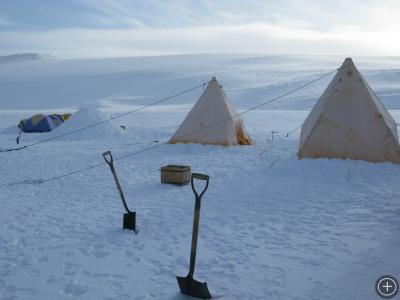

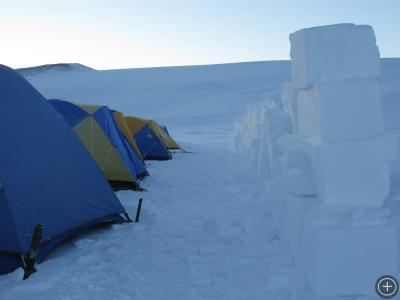
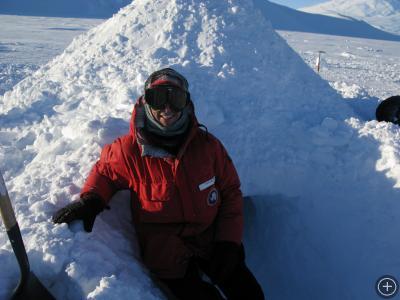
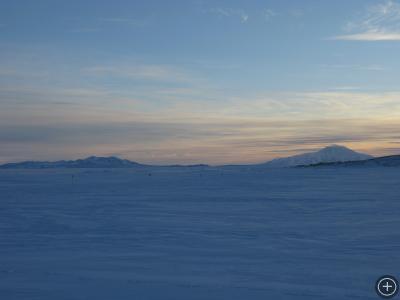

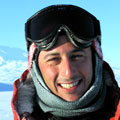

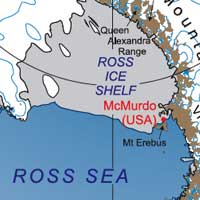





Howie,
I left a note on one of your other sites. What an adventure! Brian called today (Nov. 5) to say things are
finally up and running. His birthday is Nov. 8 so you might tip everyone off. He sure is enjoying his trip/
work as I sure you all are. It is the chance of a lifetime with memories that will last forever. Plan to keep checking on your reports. Keep up the good work.
Patty Williams
Howie,
We enjoyed your article about Happy Camper School. We have a few questions for you. Does the inside of a quinzee get light or is it always dark inside? Can you light your stove inside one of them? How long does it take to make a Quinzee? How long does Happy Camper School last before you are finished and ready to explore or work on your research project? We wish you good luck, be safe, and hope you have fun! We would love to hear from you,.
Mrs. Hutchins’s World Explorations Class
Hello Mrs. Hutchins’s 6th grade class!
So glad to hear from you all. Thanks for your good wishes and excellent questions. I’ll answer them here.
The inside of the Quinzee we made was a brilliant color blue when there was strong sunlight shining through the packed snow. It was a glowing kind of blue that can’t really be explained. This diminshed a bit more to grey as the sun went behind clouds and after it set behind Mt. Discovery. But it never was truly dark inside. It was really warm inside because the snow acted as insulation to keep body heat in, and Antarctic cold out! To get a sense of the color, check out my upcoming blog about sea ice training and the ice cave we went into.
Happy Camper School was about 32 hours long, start to finish. We first had some in-class lectures, but before long, we were out in the field, learning how to survive in this extreme environment. There were other training courses we needed to take before we were ready to deploy to our field camp. Sea ice training was one of those. But we also had to learn how to ride snowmobiles, and how to be able to fix and maintain them.
Keep those questions coming. And now that we’re wired at our field camp, I should be able to get more blogs out for everyone!
Thank you, Mr. Koss, for responding to our questions. We feel it is a great honor to hear from a scientist such as yourself! We know you are very busy! If you don’t mind, we have a lot of questions, because as you know we are 6th graders and VERY curious.
1. How do you get connected to the internet down in the Antarctic?
2. Do you work with scientists from other countries. And if so, how do you talk to each other? What language or languages do you use to communicate?
3. Are you allowed to visit other country’s stations, or must you get special permission?
4. Now for our rather “awkward” question. What about bathroom issues? What do you do if you are in the field? We know you must keep the snow pure if your using it for water. So what do you do? Do you dig latrines or is the ground too hard or frozen for this to work?
We can’t wait to hear from you!
Mrs. Hutchins 6th Grade World Explorations Class
??????? ?? ????! ??????? ???? ? RSS-?????, ?????? ?????? ???? ?????????..
(Thanks for the post! Added the blog to my RSS-feed, now read I will be reading it on a regular basis…)
Mrs. Hutchins Class!
Thanks again for your interest in our project and all your great questions. I’ll answer your most recent questions here:
1) The internet that we use here at our field camp is sent by microwaves through repeaters back to McMurdo Station. The repeaters are basically communication towers that are on the high mountains around us. From McMurdo, we get connected to the rest of the world via satellite.
2) We are a mostly American team working on this project. The 2 drillers who drill through the sea ice so the air gun can be lowered into the water are both from New Zealand. There is a scientist doing a gravity study in conjunction with our project who is also from New Zealand. His graduate student, who is also here with us, is originally from Ireland. She lives in New Zealand as well. So the long and short of it, we all speak English.
3) Nearby McMurdo Station is Scott Base which is a New Zealand research center. Every Thursday evening is “American Night” and shuttles are run back and forth from McMurdo. Otherwise, to be able to visit Scott Base, you would need an invitation from a Kiwi. Most other research facilities are too far away from where we are in McMurdo Sound to visit.
4) Not an awkward question at all. In fact, it’s quite a common one. Let me first say that we harvest ice from an iceberg that is about 3.6km away from our camp that we melt down for our water. Because it’s an iceberg, it’s fresh water when we melt it down. If we were using snow (which there really isn’t much of near us, just a few inches covering the sea ice) it would most likely be a bit salty because the sea ice forms from frozen ocean water. To answer this question, at camp we have an outhouse tent. We have a drilled hole into (not through) the ice. Otherwise, most often everyone carries around a “pee bottle” that can be used either in our own personal tents or out in the field.
Thank you for answering our questions. We have been learning about a few of the continents around the world using technology. Antarctica is not studied in depth in our geography classes, so we wanted to spend some time learning about this “cool” place. It has been fascinating reading your posts and learning about life at the bottom of the world. Thank you for sharing your experiences with us. We’ll continue to monitor your posts and we wish you well. Keep safe!
Lynne Hutchins (the teacher)